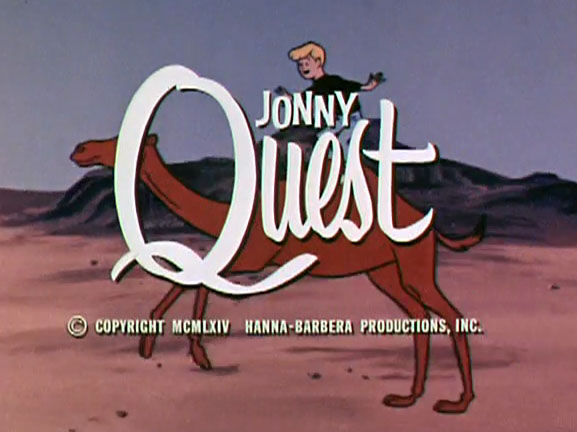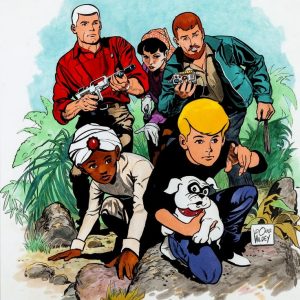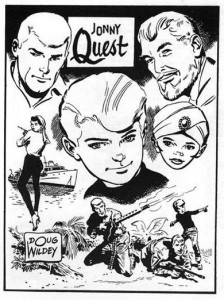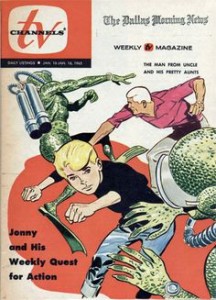



“As every child knows, the thrill of watching television is imagining yourself as the character on screen. And there was nothing more far out than slipping into Jonny Quest’s world…”
This quote from authors Joe Garner and Michael Ashley in their book It’s Saturday Morning! Celebrating the Golden Era of Cartoons, the 1960s-1990s, perfectly captures why Hanna-Barbera’s series, Jonny Quest, captured the imagination of generations.
 “What The Huckleberry Hound Show innovated for the TV short cartoon and The Flintstones for the animated situation comedy, Jonny Quest did the same for action/adventure/sci-fi/fantasy. The series set the standard for virtually everything that followed,” noted fellow Cartoon Research writer Greg Ehrbar, author of the upcoming book Hanna-Barbera: The Recorded History.
“What The Huckleberry Hound Show innovated for the TV short cartoon and The Flintstones for the animated situation comedy, Jonny Quest did the same for action/adventure/sci-fi/fantasy. The series set the standard for virtually everything that followed,” noted fellow Cartoon Research writer Greg Ehrbar, author of the upcoming book Hanna-Barbera: The Recorded History.
Celebrating its 60th anniversary this year, Jonny Quest was an amalgam of so much that was popular up to and during 1964, from “cliffhanger” radio serials to James Bond. Still, all of these elements were shaped into something all its own.
The series centered on the title character of Jonny Quest, an 11-year-old who accompanies his father on adventures. His father is Dr. Benton Quest, a widower raising Jonny as a single father and one of the world’s top scientists working for the U.S. Government.
With them is Roger “Race” Bannon, a secret agent who has been assigned to guard Jonny; Hadji Signh, the same age as Jonny, and an orphan from Calcutta, who is Jonny’s best friend and seems to possess mystical powers, and Bandit, Jonny’s rambunctious pet bulldog.

Jonny Quest was new territory for Hanna-Barbera, as it marked a change from more traditional “cartoons,” like Yogi Bear, that they had been associated with, resembling the tone of adventure comic books and live-action shows and films.
 This can be seen in the first episode, “The Mystery of the Lizard Men,” which opens with an excellent prologue, setting up the mystery that will be unraveled. Additionally, there is compelling storytelling; as agents read the files on Jonny and Dr. Quest, the audience learns their backstory (Jonny’s mother has passed, and the Quest compound is located in the Florida Keys).
This can be seen in the first episode, “The Mystery of the Lizard Men,” which opens with an excellent prologue, setting up the mystery that will be unraveled. Additionally, there is compelling storytelling; as agents read the files on Jonny and Dr. Quest, the audience learns their backstory (Jonny’s mother has passed, and the Quest compound is located in the Florida Keys).
There is also some dynamic action, including an exciting motorboat chase (and crash) toward the conclusion.
This effective staging and plotting continued through each episode with some nice touches. “The Invisible Monster” brings the title character to life as both a beautiful work of art design and an increasingly disturbing image.
The uniqueness of Jonny Quest is thanks to Doug Wildey, a cartoonist and comic artist that Hanna-Barbera brought on board to conceptualize the show’s look. Wildey’s talents resulted in something different from anything Hanna-Barbera, or any studio, had ever done. Striking character design, complete with bold black lines, reminiscent of the best comic book art, was partnered with exotic locales and exciting technology (which came from Wildey’s extensive research).
This world was brought to life thanks to a talented voice cast that included a young Tim Matheson as Jonny, Danny Bravo as Hadji, actor Mike Road as Race, and Hanna-Barbera regular John Stephenson voicing Dr. Quest in the first five episodes, with another of the studio’s voice acting stalwarts, Don Messick filling the role for the remainder of the series.
 As the backdrop for Jonny Quest was a jazzy soundtrack, unlike others. “The musical score for Jonny Quest still stands up on the same level as any great film or television score,” Ehrbar adds. “Hoyt Curtin created an unforgettable theme song that, according to him, pushed the musicians to their limits—especially the brass section. They loved the challenge. It’s also important to note that Ted Nichols was the composer. He handled a number of music cues independently of Curtin, as well as Jack de Mello. It was Nichols who continued the Hanna-Barbera ‘house sound’ for comedy and adventure cartoons from the mid-sixties to 1972 when Curtin returned to Hanna-Barbera.”
As the backdrop for Jonny Quest was a jazzy soundtrack, unlike others. “The musical score for Jonny Quest still stands up on the same level as any great film or television score,” Ehrbar adds. “Hoyt Curtin created an unforgettable theme song that, according to him, pushed the musicians to their limits—especially the brass section. They loved the challenge. It’s also important to note that Ted Nichols was the composer. He handled a number of music cues independently of Curtin, as well as Jack de Mello. It was Nichols who continued the Hanna-Barbera ‘house sound’ for comedy and adventure cartoons from the mid-sixties to 1972 when Curtin returned to Hanna-Barbera.”
Jonny Quest debuted in prime-time on ABC from September 18, 1964, through March 1965. After that, reruns were shown on Saturday morning, continuing the show’s popularity, and building its audience.
This led to the show’s return as The New Adventures of Jonny Quest in 1986 and The Real Adventures of Jonny Quest in 1996.
Sixty years later, Jonny Quest continues gaining new audiences and nostalgia-fueled love from those who grew up with the show. The series indeed did allow kids to live out their adventure-filled dreams, as noted by two other authors, Timothy Burke and Kevin Burke, in their book, Saturday Morning Fever:
“Most of the kids on Saturday morning were so annoying or useless that we rarely identified with them, but Jonny and Hadji seemed to be having so much fun on their adventures that we often wished we could be in their place.”